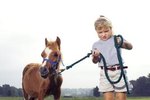
A shire horse looks like he stepped right out of a medieval fairytale, with his massive height, long mane, furred feet and giant hooves that can measure up to a foot wide. These majestic horses came straight out of the rural shires of England, such as Cambridgeshire and Lincolnshire, more than 800 years ago to ride into war, work on farms and haul heavy loads.
Size
Shire horses are known as the tallest breed of draft horse. The stallions average a colossal 17 hands, or 68 inches at the shoulder, with mares a bit smaller. Shire horses are frequent record holders for height. In comparison, riding horses like Thoroughbreds and quarter horses average between 15 and 16 hands tall, or 60 to 64 inches at the shoulder, and weigh around 1,100 pounds. Shire horses often weigh around 2,000 pounds.
Temperament
Despite their size, Shire horses are a perfect example of gentle giants. They are known for being docile, laid-back and easy to train. Spooking, bucking, rearing and shying are unusual behaviors for a shire horse. Generally, they aim to please and don't mind children, dogs, cars, water or loud noises. This mellow state of mind is often attributed to the fact that they were originally developed as war horses, a calling that required them to remain calm on a dangerous and chaotic battlefield.
History
The drive to develop strong horses originated in England during the reign of Henry II. Although not a distinct breed at that time, they were bred for the main characteristics present in modern-day Shires: massive size and calm temperament. They were used as war horses, to carry knights and heavy armor, all of which could weigh up to 400 pounds. When warfare changed and Shire horses were no longer needed in battle, they were put to work on farms and in heavy transport. In the late 1800s a breed registry was created for Shires, and since that time crossing in other breeds has become uncommon, making Shire horses a true breed of their own.
Modern Uses
Once the truck and tractor came along, machinery took over much of the farm and heavy transportation work traditionally performed by Shire horses. Some farmers and communities like the Amish still use Shire horses for plowing and hauling heavy loads. The main interest in Shire horses today is for showing and pleasure. Shires are shown not only in conformation classes but in pulling and driving competitions. Some are even shown in Western pleasure classes. Their gentle ways have also made them popular for recreational riding, despite their massive size. Shire horses are also put to work in logging operations since they can maneuver easily in places were machinery cannot
References
Photo Credits
-
Topical Press Agency/Valueline/Getty Images




